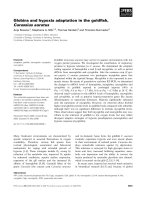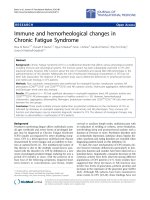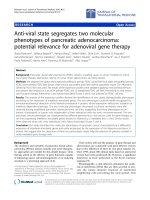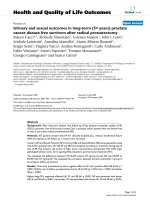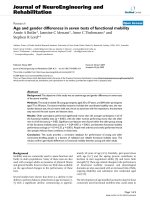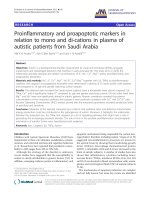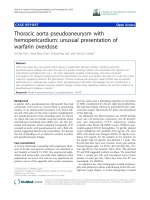Báo cáo hóa học: " Combing and self-assembly phenomena in dry films of Taxol-stabilized microtubules" pot
Bạn đang xem bản rút gọn của tài liệu. Xem và tải ngay bản đầy đủ của tài liệu tại đây (522.46 KB, 9 trang )
NANO EXPRESS
Combing and self-assembly phenomena in dry films
of Taxol-stabilized microtubules
Fabrice Olivier Morin Æ Franck Rose Æ Pascal Martin Æ
Mehmet C. Tarhan Æ Hideki Kawakatsu Æ
Hiroyuki Fujita
Published online: 13 March 2007
Ó to the authors 2007
Abstract Microtubules are filamentous proteins that act
as a substrate for the translocation of motor proteins. As
such, they may be envisioned as a scaffold for the self-
assembly of functional materials and devices. Physisorp-
tion, self-assembly and combing are here investigated as a
potential prelude to microtubule-templated self-assembly.
Dense films of self-assembled microtubules were success-
fully produced, as well as patterns of both dendritic and
non-dendritic bundles of microtubules. They are presented
in the present paper and the mechanism of their formation
is discussed.
Keywords Adsorption Á HOPG Á Microtubules Á
Self-assembly
Introduction
Microtubules (MTs) are cylindrical polymeric constructs
that are 25 nm in diameter and that, in most eukaryotic
cells, are a fundamental component of the cell cytoskel-
eton. They play an essential role in a tremendous number
of physiological processes and can self-arrange in vivo
into supra-molecular structures such as mitotic spindles.
MTs also provide a substrate suitable for the translocation
of motor proteins, most of which preferentially move
towards one of the two ends of MTs [1]; MTs are thus
functionally polarized. As a result of these unique proper-
ties, MTs have received consideration for nano-electronics
[2, 3], as a template material for metallic nano-structures
[4, 5] and as the basis for the development of nano-ma-
chines [6, 7]. We also anticipate that MTs will eventually
serve as templates for the self-assembly of functional
materials and devices in a manner comparable to the way
DNA was recently employed [8, 9]. The unique advantage
offered by the use of MTs is the multiplicity of the
possible interactions that can be exploited on top of the
physical interactions and specific bindings that are usually
involved in templated self-assembly. MTs can indeed
sustain a unique set of interactions mediated by motor
proteins (the kinesin and dynein families in particular).
Nevertheless, progress towards such MT-templated self-
assembly (especially motor-mediated) is hampered by the
fact that MTs are prone to damage and denaturation, and
that practical nano-transportation critically depends on
one’s ability to control MT polarity when arranging them
on a surface.
Such control over polarity has been reported in the
literature by several groups [10–13] while immobilization
without functional orientation—a somewhat less
demanding challenge—was achieved through several
Electronic Supplementary Material The online version of this
article (doi:10.1007/s11671-007-9044-x) contains supplementary
material, which is available to authorized users.
F. O. Morin (&) Á H. Kawakatsu Á H. Fujita
LIMMS-CNRS/IIS, UMI 2820, University of Tokyo,
4-6-1 Komaba, Tokyo 153-8505, Japan
e-mail:
F. Rose
Materials Sciences Division, L. Berkeley National Laboratory,
One Cyclotron Road - Mailstop 66RO200, Building 66, Office
212, Lab 210, Berkeley, CA 94720, USA
P. Martin
L2MP, Institut Supe
´
rieur d’Electronique et du Nume
´
rique
Maison des Technologies, Pl. G. Pompidou, Toulon 83000,
France
M. C. Tarhan
IIS, University of Tokyo, 4-6-1 Komaba, Tokyo 153-8505, Japan
123
Nanoscale Res Lett (2007) 2:135–143
DOI 10.1007/s11671-007-9044-x
avenues including covalent binding [14] and specific
adsorption [15]. Physical adsorption was also demon-
strated for immobilizing MTs onto positively charged
surfaces, the later being prepared either by formation of
self-assembled monolayers (SAMs) [16, 17] or more
simply by adsorption of polymers with a positively
charged backbone such as poly-lysine [18, 19]. To the
best of our knowledge, variations on the deposition
methods based on adsorption have never been thoroughly
investigated (although molecular combing was reported
in [20]) and neither was capillary-force-assisted MT self-
assembly. These methods have proven versatile for cre-
ating ordered structures (see for example [21–23]) and
their potential for MT self-assembly on surfaces conse-
quently deserves consideration. They are all the more
relevant when taking into account the self-organizational
properties of MTs in solution [24] that might be pre-
served during transfer on a substrate.
We thus investigated MT physisorption, self-assembly
and combing as a way to create ordered MT templates
for further assembly at the nano-scale. We only consid-
ered MTs stabilized with the drug Taxol because it is
believed to bind onto sites inside the lumen of the MTs
[25]. It thus presumably tampers minimally with the
functionality of the MT surface. We first adsorbed MTs
onto various substrates (highly oriented pyrolytic graphite
(HOPG), bare glass, poly-lysine-coated glass, Indium-Tin
Oxide (ITO) and metals such as Aluminium, Gold,
Chromium) by evaporation of droplets of MT-containing
solutions, without preliminary chemical modification of
the surfaces. We identified the parameters through which
we could control the repeatable self-assembly of struc-
tures such as dense films or bundles (dilution method,
adsorption time, presence of surfactant). We also probed
and achieved molecular combing of MTs through various
techniques: blotting and dragging MT solutions on a
surface with a filter paper and evaporating solutions
under geometrical constraints. The latter approach is
similar in concept to the capillarity-driven methods of
pattern formation reported recently [26, 27]. We also
spin-coated MT solutions in an attempt to use methods
previously applied to carbon nanotubes [28], but obtained
mixed results in terms of surface coverage and pattern
repeatability. The films obtained by the above methods
were finally characterized by several imaging techniques,
namely: field-emission scanning electron microscopy
(FESEM), atomic force microscopy (AFM) and optical
microscopy (brightfield, darkfield, fluorescence and
polarized light). The approach discussed herein will
hopefully facilitate the future development of MT-based
technologies (scaffolding and MT-templated self-
assembly) as well as MT-based devices (biosensors,
nano-machines).
Materials and methods
Preparation of microtubules
The preparation of MTs was carried out essentially as
described elsewhere [29], with a few modifications.
Tubulin (a mixture of alpha- and beta-monomers) was
prepared from four porcine brains by two cycles of tem-
perature-dependent polymerizations and phosphocellulose
chromatography. Tubulin concentration was determined by
Bradford assay. It was then stored in liquid nitrogen at a
concentration of 4 mg Á ml
–1
after appropriate dilution in a
buffer with the following composition: 100 mM Pipera-
zine-N,N’-bis(2-ethanesulfonic acid) (PIPES) adjusted
to pH 6.8 with Sodium hydroxide, 1 mM ethylene glycol-
bis(beta-aminoethyl ether)-N,N,N¢N¢-tetra-acetic acid
(EGTA), 1 mM magnesium sulfate (MgSO
4
) and 0.5 mM
guanosine 5¢-triphosphate sodium salt hydrate (GTP).
Polymerization of tubulin into MTs was induced by
thawing a 100 ll aliquot of stock tubulin, then adding
1 mM MgSO
4
and 1 mM GTP, then finally heating in a
water bath at 37 °C for 30 min. At the end of the poly-
merization step, the resulting MTs were stabilized by
adding Taxol to a final concentration of 40 lM. Fluores-
cent microtubules were prepared by polymerizing 30 llof
normal tubulin stock solution with MgSO
4
and GTP as
described above, plus 3 ll of tubulin labeled with rhoda-
mine (5-(and-6)carboxytetramethylrhodamine, Molecular
Probes C1171). The resulting solution of fluorescent MTs
was kept shielded from light at room temperature and used
within 24 h.
For use in experiments, the MT solutions were diluted
1:100 in either distilled water supplemented with 20 lM
Taxol, BRB80 buffer (80 mM PIPES, 1 mM MgCl
2
,1mM
EGTA) supplemented with 20 lM Taxol, or BRB80 sup-
plemented with 20 lM Taxol and 0.5% Triton · 100 sur-
factant (this particular buffer will hereafter be referred to as
BRB80-TX100).
Even though BRB80 is usually used for dilution in
motor assays, distilled water was used to try and circum-
vent the potential issue of salt co-deposition during the
drying of protein solutions, as well as probing the influence
of the screening of the surface charges by ions in solution.
As MTs are known to depolymerize when exposed to
distilled water, we considered that such diluted MT solu-
tions were stable only if used within 5 h of their prepara-
tion, although some shortening and a reduction in MT
density could be clearly seen to have occurred even after
this short period. Moreover, in some experiments unpoly-
merized tubulin was removed from MT solutions by cen-
trifugation in a table-top centrifuge (Chibitan-R, Millipore)
through Ultrafree MC filters (Millipore). Although this
approach is interesting insofar as it prevents free tubulin
136 Nanoscale Res Lett (2007) 2:135–143
123
from competing with MTs for whatever interaction is
available to them during experiments, it also introduces a
major uncertainty on their final concentration and, as such,
was not systematically used.
Preparation of samples
Various substrates were used for deposition of droplet of
MT-containing solution. Clean bare glass substrates, both
hydrophobic (Matsunami cover glasses Neo 24 · 36 mm)
and hydrophilic (Matsunami S7213 glass slides), as well as
poly-lysine-coated glass substrates (Matsunami S7111
glass slides) were used without chemical modification.
Highly Oriented Pyrolytic Graphite (HOPG, ZYH grade,
Veeco Metrology Group) was used freshly cleaved. For
investigation of the interaction of the MT solution with
electrically conductive substrates, various metals (Alu-
minium, Gold, Chromium) were evaporated, and Indium-
Tin Oxide was sputtered onto cleaned glass cover slides.
All samples were prepared by one of either the follow-
ing methods: (1) drop drying: a 4-ll drop of solution was
deposited onto the sample, placed in a Petri dish and left to
dry at room temperature for 24 h on a workbench. (2)
blotting and combing: a 2-ll drop of solution was depos-
ited onto the sample and left to settle for one to five min-
utes, then was blotted with a filter paper. (3) Combing by
constrained evaporation: 4 ll of solution were deposited
onto the sample substrate and a cover glass (Matsunami
Neo, 24 · 18 mm) was placed directly on top of it.
Alternatively, a flow cell approximately 100 lm high was
constructed as described elsewhere [11] and 12 to 16 llof
solution were injected and left to evaporate. (4) Spin-
coating: 50 ll of solution were deposited onto glass slides
(with or without poly-lysine) which were subsequently
spun for 30 s on a standard spin-coater (Mikasa) at speeds
comprised between 300 and 3,000 rpms
Imaging methods
AFM images were obtained in air with a JEOL SPM 4200
used in tapping mode. The cantilever used were from
Olympus Co. (OMCL-AC160TS-C2) with a resonant fre-
quency of 300 kHz and a spring constant of 40 N.m
–1
.
Fluorescence images were obtained with an Olympus
BX51 microscope fitted with a · 10 lens (Olympus
UPlanFLN, N.A. 0.3), a · 50 lens (Olympus MPlanApo,
N.A. 0.95), and a · 60 lens (Olympus UPlanFLN, N.A.
0.9) for imaging wet samples under a cover glass. The
same set of lenses were used for non-fluorescent (polarized
light, brightfield and darfield) imaging. Pictures were taken
with a Nikon Coolpix 4500 digital camera, mounted on the
top port of the microscope through two adapters (Olympus
U-CDMA3 and Nikon Coolpix MCD) providing additional
magnification.
Finally, wide-area images of dried drops were obtained
with a Keyence VHX digital microscope, and SEM images
were taken on a FESEM (JEOL JS-6300F) without any
prior contrast-enhancing treatment of the samples.
Results and discussion
Droplet drying
The observed MT self-assembly phenomena were depen-
dant on the deposition methods as well as the substrate
employed. The most salient, controlled and reproducible
results have been summarized in Table 1 for convenience,
Table 1 Summary of salient results and observations
Deposition
method
Substrate used for deposition
Hydrophilic surface Hydrophobic surface HOPG
BRB80 DIW BRB80 DIW BRB80 DIW
Blotted and
dragged
No SA No SA Combing & dendritic
bundles
No SA No SA MTs, combing and
MT
supra-assemblies
Constrained Dendritic
bundles
No SA Dendritic bundles Dendritic
bundles
ND ND
Droplet drying Bundles Bundles &
sheaves
Crystalline film Sheaves Reticulation (with
triton X)
Dense MT films
‘‘ND’’ indicates that the experiment was not done, ‘‘No SA’’ that no self-assembled structure could be reliably imaged. The other cases are
described in detail in the text, where a proper definition of the terms ‘‘bundles’’ and ‘‘dendritic bundles’’ can also be found. ‘‘Hydrophilic
surfaces’’ refers to surfaces with a contact angle lesser than 30 degrees. The term ‘‘Hydrophobic surfaces’’ thus does not necessarily refer to
surfaces with a contact angle greater than 90 degrees. It must be noted that HOPG is not included in the ‘‘Hydrophobic surfaces’’ due to its
unique behavior.
Nanoscale Res Lett (2007) 2:135–143 137
123
and we will now present them in more detail, along with
qualitative explanations of the self-assembly processes
involved during creation of the films. It must be noted that
HOPG is not included in the ‘‘Hydrophobic surfaces’’ in
Table 1 due to the unique results obtained with this sub-
strate. The reader may refer to the supporting information
for more comments on structures and films not specifically
discussed hereafter.
Self-assembly of fluorescent MT bundles (filamentous
structures globally longer and thicker than individual MTs,
with a large dispersion in both length and thickness: see
Fig. 1) was repeatedly observed in the deposits prepared
from MT solutions that were either diluted in BRB80
buffer and drying on hydrophillic surfaces, or drying on
hydrophobic glass surfaces and diluted in BRB80 supple-
mented with the surfactant Triton X (buffer hereafter
referred to as BRB80-TX100). In both cases, the droplets
were seen to spread over an initial period of several dozen
minutes, thus producing flat droplets with large radii (up to
half a centimeter and more) and mobile (advancing) con-
tact lines. In the resulting dried deposits, digital micros-
copy revealed the presence of a crystal-like film, most
likely formed from the salts in solution: indeed, the mar-
ginal staining by rhodamine suggests that the proportion of
depolymerized tubulin in the film is low. Fluorescence
microscopy of the latter revealed that it contained many
fluorescent MTs, especially on the outer side of the deposit:
some MTs apparently retained their individual character,
but most had clearly self-organized into bundles of various
sizes (Fig. 1a and b). These were under or inside the
crystalline film, as revealed by electronic microscopy,
brightfield and digital microscopy (Fig. 1d). The fact that
some of the MT bundles could be seen by the latter two
microscopy techniques underlines the difference in diam-
eter between these and the individual MTs in the initial
solution, since without fluorescence, individual MTs can
only be visualized with contrast-enhancing techniques such
as darkfield and Nomarski.
Bundle self-assembly has already been described ([30,
31]) in MT solutions supplemented with either positively
charged species (electrostatic interactions related to charge
inversion phenomena) or inert molecules (steric exclusion).
Bundle formation in our experiments seems to obey a
different mechanism and can partially be explained by
Fig. 1 Formation of MT bundles on various substrates. (a–c)
Fluorescence imaging of microtubules deposited on glass by drying
from a MT dilution in BRB80-TX100: (a) and (b) on glass, (c)on
HOPG. (a) Difference between coronal (bottom left-hand side: fairly
homogeneous accumulation of MT bundles) and central area (upper
right-hand side: inhomogeneous reticulation of MT bundles) of the
deposit. (b) MT bundles of various sizes are seen to form entangle. (c)
Reticulation of the film on HOPG; the coronal area of the image is
slightly out of focus due to the local relief of the HOPG surface. (d)
Image obtained by digital microscopy in the central area of an
Aluminium substrate: there, bundles are partially covered by the non-
fluorescent film, although in some places the latter also appears in
between bundles, filling cells of the bundle network
138 Nanoscale Res Lett (2007) 2:135–143
123
considering the structure of fluid flow inside the drying
droplet. Flow lines are indeed present that are mostly
attributed to the joint action of contact line pinning and
evaporation [32], although other phenomena may also take
place under specific experimental conditions [33], such as
Marangoni effect or thermal flow. Corresponding zones of
dead flow are created where MTs progressively accumu-
late, especially near the contact line of the drop. There,
regardless of whether the contact line is pinned or slowly
advancing, MTs agglomerate and form bundles oriented
parallel to the contact line, progressively forming a nematic
phase where bundles appear. This scenario thus differs
from MT bundle formation by condensing agents previ-
ously studied [34] and is actually more similar to recent
observations of DNA bundle formation in dried droplets
[35]. The precise nature of the interaction between MTs
inside a bundle is unclear, although electrostatic attraction
between rodlike, like-charged polyelectrolytes has been
extensively studied both theoretically and experimentally
(see for example [36]). The observation of the organization
of Mg counterions around and between individual MTs will
undoubtedly provide valuable insights into the mechanism
of bundle formation, in a manner similar to the reported
results on F-actin [37]. The exact composition and inner
structure of the bundles, as well as the fate of individual
MTs once they become part of them, is also still to be
investigated. In particular, an important question from a
technological point of view is whether these bundles can
still provide physiological functions associated with MTs,
such as supporting the movement of motor proteins.
As for the film that covered the self-assembled bundles,
we repeatedly observed across most samples a difference in
nature between a coronal area on the outside of the drop
(homogeneous film) and the central area of the deposit
(strongly reticulated film). This difference can be seen
clearly in Fig. 1a) and can be explained by the dewetting
properties of the solutions. This hypothesis is in good
agreement with the results presented by [38] and is sup-
ported by the difference in reticulation patterns observed
on different substrates (Fig. 1a, c and d): with dilutions in
BRB80-TX100 on HOPG, in particular, the edges of the
bundle network were thinner and more homogeneous in
size than on other surfaces (Fig. 1c). Contrary to the
reticulation, however, the difference between the central
and outer area of the dried films is a phenomenon that is of
a very general nature and is mostly due to two phenomena:
(1) the omnipresence of the outward capillary flow, and (2)
the formation of a solid crust due to salt crystallization, the
presence of which has been shown to influence the final
shape of the dried deposit [39].
Taken together, these observations indicate that the
differences existing between the final deposits depend
mainly on 3 factors: (1) the contact angle of the droplet
with the substrates; (2) the pinning (or lack thereof) of the
contact line; (3) the physico-chemical properties of the
solutions per se. The contact angle is the main parameter
controlling the radius of the drying droplet. It thus deter-
mines its evaporation dynamics, the distribution of the
species in solution and the local solute concentrations
reached during evaporation. For example, droplets of MT
solutions diluted in BRB80 drying on hydrophobic surfaces
had a pinned contact line and a high contact angle: thus
they had a smaller radius and produced very specific
deposits, characterized by the presence of a thick film.
Interestingly, polarized light microscopy revealed the
existence of wide-area domains (see Fig. S1 in supporting
information) that could individually be brought to extinc-
tion by rotation of the sample relative to the crossed
polarizers. This is indicative of long-range structural
ordering inside the film that can be attributed to both the
existence of a MT nematic phase and/or the crystallization
of the salts from the buffer. This likely indicates that
critical concentrations for crystal growth were reached
during evaporation, and one may even hypothesize that
MTs possess the ability to modulate the growth of inor-
ganic crystals, as is the case for other proteins [40, 41].
The one remarkable exception to the patterns of droplet
drying described above was obtained with HOPG: on this
substrate, when using fluorescent MTs diluted in water,
films of densely packed MTs self-assembled upon drying
inside which individual MTs could be resolved by AFM
(Fig. 2). The AFM pictures clearly show the self-organi-
zation of the MTs inside the film: they form 2-dimensional
rafts of one or two dozens of MTs that together provide a
very uniform cover of the surface. MTs do not form bun-
dles, as seen from the width (about 120 nm) of the fila-
mentous structures imaged by AFM (Fig. 2b, d). Taking
into account the convolution with the shape of the AFM
tip, this measured value is in accordance with previously
reported diameters for dried MTs measured by AFM, even
though it is well above the theoretical 25 nm diameter of
free MTs. We purposefully damaged these films by running
the AFM tip across the surface while maintaining contact
(Fig. 2c). By measuring the profiles of the resulting scrat-
ches (Fig. 2e), we determined the thickness of this film to
be around 11 nm, which corresponds to a single layer of
adsorbed MTs [18, 17]. The details of the mechanism
through which such homogeneous films form at the surface
of HOPG are unclear. In particular, non-fluorescent MTs
seem to behave differently from fluorescently-labeled ones
in terms of self-assembly on HOPG. It may be that the
combination of the presence of the label and the low ionic
density of the solution favors electrostatic interactions,
leading to this particular type of self-assembly (it has to be
noted, however, that no similar self-assembly was observed
on other conductive substrates such as Aluminium, Chro-
Nanoscale Res Lett (2007) 2:135–143 139
123
mium, Gold and ITO). If this is indeed the case, the ability
to polymerize MTs from various types of modified tubulin
may provide an elegant way to control template formation.
In any case, the dense films that were produced on HOPG
show great promise for biosensor applications where
electrochemical methods are to be used.
Combing by blotting and evaporation under
geometrical constraints
Very different self-assembled structures were obtained by
blotting MT solutions diluted in BRB80 or letting them
evaporate under geometrical constraints. These techniques
unequivocally demonstrated the ability to comb MTs and
MT bundles on a substrate. Evaporation of MT solutions
diluted in BRB80 inside flow cells, in particular, reliably
produced large-area patterns of aligned dendritic structures
(Fig. 3a) that were reminiscent of reported constructs
obtained from DNA [42, 43]. With this technique, we
demonstrated self-assembly of dendritic bundles of MTs
during the drying process, as depicted in Fig. 3f: some
MTs were indeed pinned onto the substrate, probably by a
defect of the surface that ‘‘recruited’’ other MTs from the
solution to form an agglomerate; these were subsequently
elongated by the slowly receding contact line, locally
deforming the latter in the process before passing through it
and finally being left behind (Fig. 3b, c). The branching
structure of these bundles is correlated to the direction of
the movement of the receding contact line: due to capillary
interactions resulting from the deformation of the contact
line, adjacent bundles indeed tend to aggregate if they are
sufficiently close, forming the observed dendritic structures
(Fig. 3f). The latter thus form before the main trunk of the
bundle, which is on average longer than the branching
dendrites.
AFM imaging revealed a height of 10 to 15 nm for these
particular bundles, but it was not possible to investigate
further their inner structure. How much of the MTs are
actually left inside is thus an open question, as well as the
possible polymerization of tubulin into exotic structures.
Although the parallel arrangement of MT bundles was the
overwhelmingly dominant pattern, individual MTs were
also found to be combed on the surface, albeit in smaller
patches. Even then, they were often seen to make contact
with or twist around one another (Fig. 3e). For producing
combed individual MTs, blotting and dragging produced
better results, problably because the contact line receded
faster. Spin-coating at high speeds (2,000–3,000 rpms)
actually also produced interesting results, even though the
resulting combing patterns were difficult to reproduce and
strongly inhomogeneous across the surface (see Fig. S2 in
supporting information). Finally, observation of the films
Fig. 2 AFM topographs of
microtubules deposited on
HOPG by drying from a MT
dilution in water. (a) self-
assembly of dense MT films
forming a continuous coverage
of the HOPG surface. (b) Zoom
on the upper right-hand corner
of picture (a). (c) Intentional
damage applied to the MT film
through the AFM tip. (d) AFM
profile of the MT film as
indicated by the arrow in (b). (e)
AFM profile of the scratch
indicated by the arrow in (c):
the measured depth is around
11 nm, which shows that the
film is a monolayer
140 Nanoscale Res Lett (2007) 2:135–143
123
obtained at the edges of flow cells showed both the bundles
left behind by the receding contact line (and thus combed
perpendicularly to it) and those aligned in the dead zone of
the outward capillary flow (Fig. 3d). Considering the ori-
entation of the dendritic structure of the combed bundles
thus suggests the initial formation of a solid crust at the air-
liquid interface: the latter immobilized the bundles aligned
in the dead flow areas before the contact line started
receding. These observations thus underline the funda-
mental influence of contact line pinning on the final
structure and orientation of the deposited microtubules.
Finally, we observed peculiar patterns of self-assembly
on samples prepared on HOPG by blotting MT solutions
diluted in water. Several large crystals were indeed
observed, with regions between them rich in films con-
taining MTs that could readily be imaged by AFM (see
Fig. S3 in supporting information). These MTs formed
multi-layer films and exhibited a surprisingly rich reper-
toire of patterns of organization: in some areas, MTs were
arranged densely but randomly (Fig. 4a, c), forming an
incomplete, discontinuous layer on the surface, on top of
which different self-assembled structures could be seen
(Fig. 4a, b). In other areas, the MT density was markedly
lesser and some individual MTs were locally combed. The
combing effect did not follow the HOPG steps (Fig. 4d),
contrary to what happens in some specific cases with DNA
[44]. Moreover, in all many cases we observed that some
MTs would ‘‘stick together‘‘ along their main axis, which
was likely caused by capillary forces during drying. The
same explanation could account for the observation of
large bundle structures (Fig. 4a) of various sizes, seem-
ingly stiffer than individual MTs as denoted by their rec-
titude over several micrometers (Fig. 4b, c). The structure
of these bundles is unclear. In particular, the existence and
nature of some form of ligand between the individual
tubular structures inside the bundles is an open question.
Considering the sheaves formed in water by Taxol (see Fig.
S4 in supporting information), its role in the formation of
such large bundles should also be investigated. Another
salient feature of the AFM images is that many MTs were
observed to disappear under a film left behind during
blotting (Fig. 4e). The latter is likely composed of salt
crystals, even though, given the dilution in water, it may
also comprise depolymerized tubulin. Interestingly, this
film seems to have occasionally been pinned during drying
by the individual MTs, (this is clearly highlighted in
Fig. 4f), thus showing that those MTs perpendicular to the
contact line of the receding liquid have a better chance to
remain free on the surface after drying.
Summary and perspectives
In the present work, we studied the physisorption of Taxol-
stabilized MTs as a step towards MT-templated self-
assembly. We probed the influence of the nature of the
substrate, of the dilution methods and of the deposition
protocols on the resulting adsorbed films. We thus suc-
cessfully produced dense films of self-assembled MTs on
HOPG by drying droplets of water-diluted MT solutions.
Auto-assembled, non-dendritic bundles were also produced
by solvent evaporation on surfaces having a low contact
angle with the drying solution, a state that could be attained
by addition of a surfactant (Triton X 100) when necessary.
This method differs from those previously reported in the
literature, based on either charge inversion or steric
Fig. 3 Formation of dendritic MT bundles by receding contact line.
(a–d) Fluorescent imaging of MT structures self-assembled on glass
from a MT solution prepared by dilution in BRB80. Pictures (b)
(taken during the evaporation of a droplet) and (d) (taken at the border
of the cover of a flow cell after drying) show the concurrent formation
of dendritic and non-dendritic bundles. Non-dendritic bundles are
oriented roughly perpendicular to the dendritic ones. In picture (b),
they also bend periodically due to compressive stress. (e) AFM
imaging shows combing of individual microtubules after blotting. (f)
Formation mechanism of the dendritic bundles: (1) MTs randomly
float in solution. (2) The contact line (blue) recedes, along which MTs
accumulate and orientate. (3) MTs are pinned on defects of the
surface (red dots) and induce the deformation of the receding contact
line. An MT entanglement area appears (green circle). (4) MTs self-
arrange into dendrites under the action of capillary forces. (5) The
contact line breaks free from the deposited MTs and continues its
recession
Nanoscale Res Lett (2007) 2:135–143 141
123
exclusion. Finally, self-assembly of MT dendritic bundles
was achieved by evaporation under geometrical constraints
such as a flow cell. The electronic, optical and biological
properties of the various bundles described in the present
work will be interesting to study as they may be used in the
future beyond their intended role as templates for self-
assembly of functional materials.
Our observations of droplet evaporation show that the
interplay between MT self-organization, interactions with
the surface and capillary flow controls the final shape,
structure and homogeneity of the final dried deposit. The
implication of these observations is that production of
spotted arrays of MTs on glass or silicon substrates (similar
to DNA arrays) must take into account the evaporation
dynamics of the spotted droplets, and that strategies must
be developed so as to obtain MTs that are both functional
and free from any film above them.
Moreover, the combing of both individual MTs and MT
bundles that was achieved when using MT solutions dried
in flow cells or blotted and dragged across a surface opens
intriguing possibilities. The directionality of the structures
produced by these methods could be of particular interest
for nano-transportation systems provided the combed
structures exhibit at least some of the physiological func-
tions associated with individual MTs. This point is of
crucial importance and is still under investigation. If the
combed structures still support translocation of motor
proteins, the combing techniques described in the present
work will have important practical applications for both the
development of both nano-machines and MT-templated
self-assembly technology.
Finally, the results presented here also point at a strong
specific interaction between HOPG surface and MTs in
solution with low ionic strength. Although the nature of
this interaction is not fully understood, it could be
exploited to reliably produce dense and homogeneous films
of adsorbed MTs. This, coupled with the ability to fabricate
devices integrating HOPG micro-electrodes [45], may pave
the way to the development of electrochemical sensors
integrating MTs. One may thus envision designing assays
based on this technology to quantify the interactions of
proteins and molecules with MTs, which, given MT
implication in heavy pathologies (cancer, Alzheimer’s),
represents a considerable—and, as yet, unex-
plored—opportunity for pharmaceutical research.
Acknowledgments F.O.M. and F.R. acknowledge the financial
support of the Japan Society for the Promotion of Science (JSPS).
P.M. acknowledges the financial support of the Centre National de la
Recherche Scientifique (CNRS). F.O.M. and M.C.T. acknowledge
prof. S. Takeuchi for permitting the use of ultra-centrifuges.
Fig. 4 AFM imaging of MTs
arranged on HOPG by blotting
and dragging. (a–c) Large
supra-molecular assembly of
MTs laying on top of a network
of entangled individual MTs.
(b) Close-up of the supra-
molecular structure depicted in
a); the MTs comprising the
supra-molecular structure are
straightened. (c) Close-up of the
entangled MT network depicted
in (a); grouping and
straightening is also observed
within this network, albeit
involving fewer MTs. (d)
Individual MTs laid across steps
(horizontal stripes) in HOPG.
(e–f) Individual MTs
disappearing under a film; as
highlighted in (f), the film has
formed between some MTs,
probably as a result of liquid
pinning by these MTs during the
drying process
142 Nanoscale Res Lett (2007) 2:135–143
123
References
1. N. Hirokawa, R. Takemura, Nature Rev. Neurosc. 6, 201–214
(1995)
2. W. Fritzsche, J.M. Ko
¨
hler, K.J. Bo
¨
hm, E. Unger, T Wagner, R.
Kirsch, M. Mertig, W. Pompe, Nanotechnology 10, 331–335
(1999)
3. W. Fritzsche, K.J. Bo
¨
hm, E. Unger, J.M. Ko
¨
hler, Appl. Phys.
Lett. 75, 2854–2856 (1999)
4. S. Behrens, K. Rahn, W. Habicht, K.J. Bo
¨
hm, H. Ro
¨
sner, E.
Dinjus, E. Unger, Advanced Mat. 14, 1621–1625 (2002)
5. S. Behrens, W. Habicht, J. Wu, E. Unger, Surf. Interf. Anal 38,
1014–1018 (2006)
6. L. Jia, S.G. Moorjani, T.N. Jackson, W.O. Hancock, Biomed.
Microdev. 6, 67–74 (2004)
7. H. Hess, G.D. Bachand, V. Vogel, Chem. Eur. J. 10, 2110–2116
(2004)
8. H. Yan, S.H. Park, G. Finkelstein, J.H. Reif, T.H LaBean, Sci-
ence 301, 1882–1884 (2003)
9. J. Zheng, P.E. Constantinou, C. Micheel, A.P. Alivisatos, R.A.
Kiehl, N.C. Seeman, Nano Lett. 6, 1502–1504 (2006)
10. R. Stracke, J. Burghold, H.J. Schacht, K.J. Bo
¨
hm, E. Unger,
Nanotechnology 11, 52–56 (2000)
11. R. Yokokawa, S. Takeuchi, T. Kon, M. Nishiura, K. Sutoh, H
Fujita, Nano Lett. 4, 2265–2270 (2004)
12. L. Limberis, J.J. Magda, R.J. Stewart, Nano Lett. 1, 277–280
(2001)
13. Y. Yang, P.A. Deymier, L. Wang, R. Guzman, J.B. Hoying, H.J.
McLaughlin, S.D. Smith, I.N. Jongewaard, Biotech. Progress 22,
303–312 (2006)
14. W. Roos, J. Ulmer, S. Gra
¨
ter, T. Surrey, J.P. Spatz, Nano Lett. 5,
2630–2634 (2005)
15. G. Muthukrishnan, C.A. Roberts, Y C. Chen, J.D. Zahn, W.O.
Hancock, Nano Lett. 4, 2127–2132 (2004)
16. A. Vinckier, I. Heyvaert, A. D’Hoore, T. McKittrick, C.V.
Haesendonck, Y. Engelborghs, L. Hellemans, Ultramicroscopy
57, 337–343 (1995)
17. P.J. de Pablo, I.A.T. Schaap, C.F. Schmidt, Nanotechnology 14,
143–146 (2003)
18. W. Vater, W. Fritzsche, A. Schaper, K.J. Bo
¨
hm, E. Unger, T.M.
Jovin, J. Cell Sc. 108, 1063–1069 (1995)
19. Y. Yang, R. Guzman, P.A. Deymier, M. Umnov, J. Hoying, S
Raghavan, O. Palusinski, B.J.J. Zelinski, J. Nanosc. Nanotech. 5,
2050–2056 (2005)
20. W. Fritzsche, K.J. Bo
¨
hm, E. Unger, J.M. Ko
¨
hler, Nanotechnology
9, 177–183 (1998)
21. M. Maillard, L. Motte, M P. Pileni, Advanced Mat. 13, 200–204
(2001)
22. E. Rabani, D.R. Reichman, P.L. Geissler, L.E. Brus, Nature 426,
271–274 (2003)
23. M.A. Ray, H. Kim, L. Jia, Langmuir 21, 4786–4789 (2005)
24. J. Tabony, N. Glade, J. Demongeot, C. Papaseit, Langmuir 18,
7196–7207 (2002)
25. E. Nogales, M. Whittaker, R.A. Milligan K.H. Downing, Cell 96,
79–88 (1999)
26. Z. Lin, S. Granick, J. Am. Chem. Soc. 127, 2816–2817 (2005)
27. S.W. Hong, J. Xu, J. Xia, Z. Lin, F. Qiu, Y. Yang, Chem. Mat. 17,
6223–6226 (2005)
28. A.B. Dalton, A. Ortiz-Acevedo, V. Zorbas, E. Brunner, W.M.
Sampson, S. Collins, J.M. Razal, M. Miki Yoshida, R.H.
Baughman, R.K. Draper, I.H. Musselman, M. Jose-Yacaman,
G.R. Dieckmann, Adv. Funct. Mat. 14, 1147–1151 (2004)
29. R. Yokokawa, Y. Yoshida, S. Takeuchi, T. Kon, H. Fujita,
Nanotechnology 17, 289–294 (2006)
30. J.X. Tang, S. Wong, P.T. Tran, P.A. Janmey, Ber Bunsenges.
Phys. Chem. 100, 796–806 (1996)
31. J.X. Tang, T. Ito, T. Tao, P. Straub, P.A. Janmey, Biochemistry
36, 12600–12607 (1997)
32. R.D. Deegan, O. Bakajin, T.F. Dupont, G. Huber, S.R. Nagel,
T.A. Witten, Nature 389, 827–829 (1997)
33. Y.Y. Tarasevich, Phys. Uspekhi 47, 717–728 (2004)
34. D.J. Needleman, M.A. Ojeda-Lopez, U. Raviv, K. Ewert,; H.P.
Miller, L. Wilson, C.R. Safinya, Proc. Nat. Acad. Sc. USA 101,
16099–16103 (2004)
35. I.I. Smalyukh, O.V. Zribi, J.C. Butler, O.D. Lavrentovich, G.C.L.
Wong, Phys. Rev. Lett. 96, 177801 (2006)
36. O.V. Zribi, H. Kyung, R. Golestanian, T.B. Liverpool, G.C.L.
Wong, Phys. Rev. E 73, 031911 (2006)
37. T.E. Angelini, H. Liang, W. Wriggers, G.C.L. Wong, Eur. Phys.
J. E 16, 389–400 (2005)
38. L.W. Schwartz, R.V. Roy, R.R. Eley, S. Petrashy, J. Coll. Interf.
Sc. 234, 363–374 (2001)
39. T. Kajiya, E. Nishitani, T. Yamaue, M. Doi, Phys. Rev. E 73,
011601 (2006)
40. K. Shiba, T. Honma, T. Minamisawa, K. Nishiguchi, T. Noda,
EMBO Reports 4, 148–153 (2003)
41. B. Szabo
´
, T. Vicsek, Phys. Rev. E 67, 011908 (2003)
42. G. Maubach, W. Fritzsche, Nano Lett. 4, 607–611 (2004)
43. T. Heim, S. Preuss, B. Gerstmayer, A. Bosio, R. Blossey, J. Phys.
Cond. Matt. 17, S703–S716 (2005)
44. F. Rose, P. Martin, H. Fujita, H. Kawakatsu, Nanotechnology 17,
3325–3332 (2006)
45. A.M. Oliveira Brett, DNA-based biosensors. In: Biosensors and
Modern Biospecific Analytical Techniques, Volume XLIV
(Comprehensive Analytical Chemistry), ed. by L. Gorton,
(Elsevier Science: Amsterdam, 2005)
Nanoscale Res Lett (2007) 2:135–143 143
123

